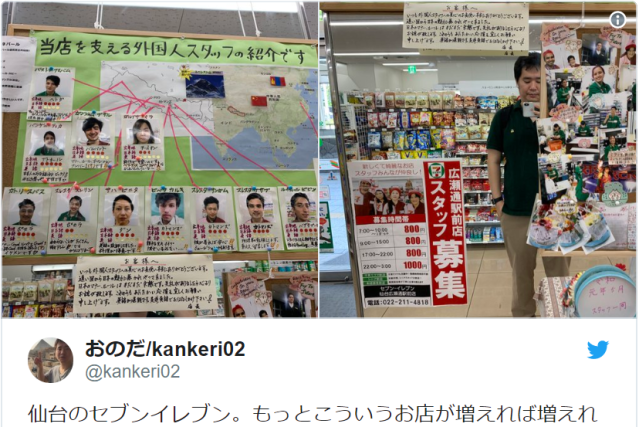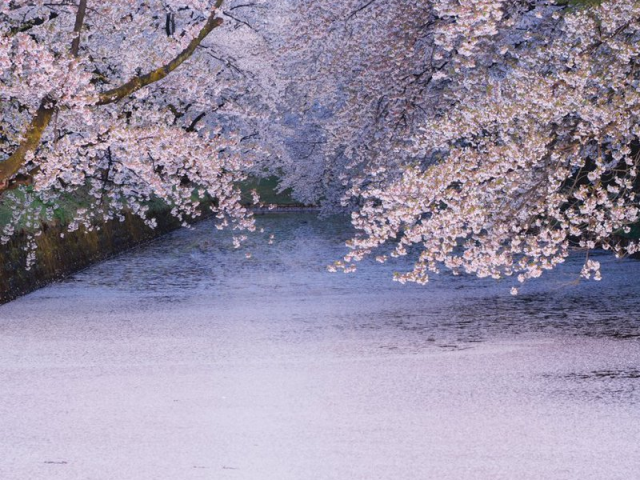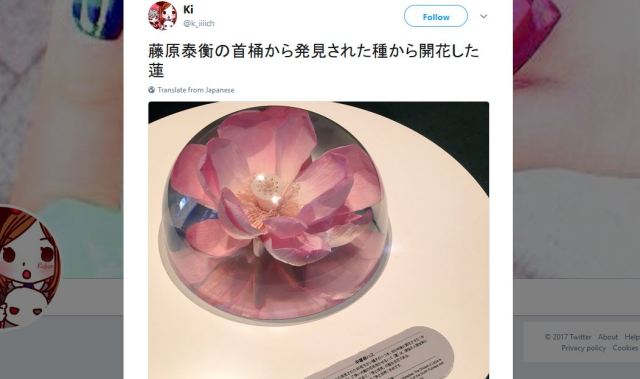Rather than forget the horrors of the disaster, this coastal town has set up daily reminders of the tsunami on the streets.
Tohoku (Page 2)
Donations will be made for each person who runs a search for information about the tragedy, with funds helping farmers, students, and those suffering from depression and loneliness.
Gentle giant Pokémon is helping prefecture damaged in Tohoku earthquake and tsunami recover.
Customers who were curious about the smiling foreign workers ringing up their order at this local konbini can now learn a little bit about what they have in common.
The conclusion of our slow-life adventure to Japan’s northernmost prefecture with trains, hot springs, and so muh delicious seafood.
Skip the Shinkansen and savor the journey with Japan’s ultra-affordable unlimited-use one-day rail passes.
The tear-jerking video encourages viewers to “Search for 3.11” on the anniversary to help support reconstruction in the region.
Ethereally romantic images remind us why a wintertime visit to a snow-covered onsen resort is extra special.
Adorably awesome Pokémon train is part of disaster relief project for tsunami-damaged region.
People in Japan responded to the remark with a heartwarming hashtag that immediately went viral, showing support for the Tohoku region.
Planning to spend much, but not all, of your Japan trip in Tokyo? Then this could be an unbeatable deal.
The eerie ruins of this once-thriving amusement park look set to become Japan’s next unusual place to visit.
We traveled to the disaster-stricken Tohoku region to see the effects of Pocket Monster Lapras’ real-world healing powers.
The Okada Theater was swept away in 2011, but Pokémon GO players are still visiting its location, and learning a little about this tsunami-ravaged city in the process.
The venture is being promoted by a local branch of Loft chainstores to help revitalise the Tohoku area.



















 China’s don’t-go-to-Japan warning seems to be affecting Osaka’s Namba and Dotonbori neighborhoods
China’s don’t-go-to-Japan warning seems to be affecting Osaka’s Namba and Dotonbori neighborhoods Here are the top ten foodie factory tours for the fall throughout Japan
Here are the top ten foodie factory tours for the fall throughout Japan Japanese company selling bear-proof automatic doors
Japanese company selling bear-proof automatic doors The 10 best day trips from downtown Tokyo【Survey】
The 10 best day trips from downtown Tokyo【Survey】 Anime Industry Report shows overseas anime market is bigger than Japanese one, but is this a cultural tipping point?
Anime Industry Report shows overseas anime market is bigger than Japanese one, but is this a cultural tipping point? Kyoto’s “ikezu” culture of backhanded compliments explained in hilarious souvenir sticker series
Kyoto’s “ikezu” culture of backhanded compliments explained in hilarious souvenir sticker series Getting a driver’s license in Japan the hard way: The first driving test a few more times
Getting a driver’s license in Japan the hard way: The first driving test a few more times You can now buy a Japanese train station clock in Japan
You can now buy a Japanese train station clock in Japan You can now visit a recreation of Evangelion’s Tokyo-3 and live there in miniature form in【Pics】
You can now visit a recreation of Evangelion’s Tokyo-3 and live there in miniature form in【Pics】 Viral 3D ice creams land in Japan… but are they worth the hype?
Viral 3D ice creams land in Japan… but are they worth the hype? Japan’s human washing machines will go on sale to general public, demos to be held in Tokyo
Japan’s human washing machines will go on sale to general public, demos to be held in Tokyo Nintendo’s Kirby now delivering orders at Kura Sushi restaurants, but not in Japan
Nintendo’s Kirby now delivering orders at Kura Sushi restaurants, but not in Japan Japan considering raising international traveler departure tax even more than previously reported
Japan considering raising international traveler departure tax even more than previously reported Is China’s don’t-go-to-Japan warning affecting tourist crowds in Shibuya’s Don Quijote?
Is China’s don’t-go-to-Japan warning affecting tourist crowds in Shibuya’s Don Quijote? Is China’s don’t-go-to-Japan warning affecting tourist crowd sizes in Nara?
Is China’s don’t-go-to-Japan warning affecting tourist crowd sizes in Nara? Studio Ghibli stamps lift your spirits with motivational phrases from Totoro
Studio Ghibli stamps lift your spirits with motivational phrases from Totoro Japanese town suing resident for being a jerk
Japanese town suing resident for being a jerk Is Kyoto less crowded with tourists after China’s don’t-go-to-Japan warning?【Photos】
Is Kyoto less crowded with tourists after China’s don’t-go-to-Japan warning?【Photos】 Japanese police attempting to clamp down on “zombie cigarettes”
Japanese police attempting to clamp down on “zombie cigarettes” Starbucks Japan unveils new Christmas goods and a rhinestone tumbler that costs 19,500 yen
Starbucks Japan unveils new Christmas goods and a rhinestone tumbler that costs 19,500 yen Real-world Nausicaa Ghibli anime glider completes its final flight in Japan【Video】
Real-world Nausicaa Ghibli anime glider completes its final flight in Japan【Video】 Brand-new Pokémon park opens in Japan with larger-than-life-size Lapras【Photos】
Brand-new Pokémon park opens in Japan with larger-than-life-size Lapras【Photos】 Japanese train company is letting fans buy its actual ticket gates for their homes
Japanese train company is letting fans buy its actual ticket gates for their homes Is China’s don’t-go-to-Japan warning affecting tourist crowds in Tokyo’s Asakusa neighborhood?
Is China’s don’t-go-to-Japan warning affecting tourist crowds in Tokyo’s Asakusa neighborhood? Naturally brown-haired Osaka student sues government for forcing her to dye her hair black
Naturally brown-haired Osaka student sues government for forcing her to dye her hair black Japanese government considering tripling departure taxes to combat overtourism
Japanese government considering tripling departure taxes to combat overtourism Unique inclined elevator in Japan leads to a town that inspired Studio Ghibli’s Spirited Away
Unique inclined elevator in Japan leads to a town that inspired Studio Ghibli’s Spirited Away Survey asks foreign tourists what bothered them in Japan, more than half gave same answer
Survey asks foreign tourists what bothered them in Japan, more than half gave same answer Japan’s deadliest food claims more victims, but why do people keep eating it for New Year’s?
Japan’s deadliest food claims more victims, but why do people keep eating it for New Year’s? We deeply regret going into this tunnel on our walk in the mountains of Japan
We deeply regret going into this tunnel on our walk in the mountains of Japan Studio Ghibli releases Kodama forest spirits from Princess Mononoke to light up your home
Studio Ghibli releases Kodama forest spirits from Princess Mononoke to light up your home Major Japanese hotel chain says reservations via overseas booking sites may not be valid
Major Japanese hotel chain says reservations via overseas booking sites may not be valid Put sesame oil in your coffee? Japanese maker says it’s the best way to start your day【Taste test】
Put sesame oil in your coffee? Japanese maker says it’s the best way to start your day【Taste test】 The top 10 annoying foreign tourist behaviors on trains, as chosen by Japanese people【Survey】
The top 10 annoying foreign tourist behaviors on trains, as chosen by Japanese people【Survey】 No more using real katana for tourism activities, Japan’s National Police Agency says
No more using real katana for tourism activities, Japan’s National Police Agency says Starbucks Japan reveals new sakura drinkware collection, inspired by evening cherry blossoms
Starbucks Japan reveals new sakura drinkware collection, inspired by evening cherry blossoms Kyoto’s “ikezu” culture of backhanded compliments explained in hilarious souvenir sticker series
Kyoto’s “ikezu” culture of backhanded compliments explained in hilarious souvenir sticker series Getting a driver’s license in Japan the hard way: The first driving test a few more times
Getting a driver’s license in Japan the hard way: The first driving test a few more times You can now buy a Japanese train station clock in Japan
You can now buy a Japanese train station clock in Japan You can now visit a recreation of Evangelion’s Tokyo-3 and live there in miniature form in【Pics】
You can now visit a recreation of Evangelion’s Tokyo-3 and live there in miniature form in【Pics】 Viral 3D ice creams land in Japan… but are they worth the hype?
Viral 3D ice creams land in Japan… but are they worth the hype? Everything you wanted to know about the Ainu, with photos and video【Rocketpedia】
Everything you wanted to know about the Ainu, with photos and video【Rocketpedia】 We deeply regret spending five hours on this artistic Japanese island (we should have spent more)
We deeply regret spending five hours on this artistic Japanese island (we should have spent more) This Osaka laundromat wants to clean more than your clothes; it also wants to clean you
This Osaka laundromat wants to clean more than your clothes; it also wants to clean you Mr. Sato attempts the 50-Pin Challenge at Kabukicho’s Shinjuku Copa Bowl【Video】
Mr. Sato attempts the 50-Pin Challenge at Kabukicho’s Shinjuku Copa Bowl【Video】 Is China’s don’t-go-to-Japan warning affecting tourist crowds in Shibuya’s Don Quijote?
Is China’s don’t-go-to-Japan warning affecting tourist crowds in Shibuya’s Don Quijote? Studio Ghibli stamps lift your spirits with motivational phrases from Totoro
Studio Ghibli stamps lift your spirits with motivational phrases from Totoro Cardcaptor Sakura engagement rings are here to help you capture your bride-to-be’s heart
Cardcaptor Sakura engagement rings are here to help you capture your bride-to-be’s heart